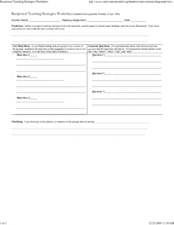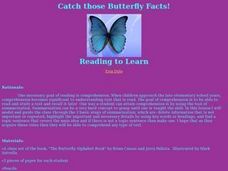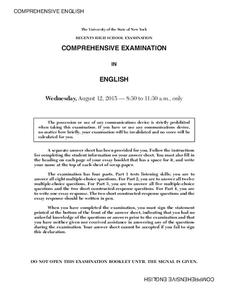Curated OER
Main Idea in Informational Text
Individuals complete a pre-assessment to gauge their ability to determine the main idea and supporting details in nonfiction text. They examine a new piece of nonfiction reading by looking at the table of contents, headings, and index...
Curated OER
Finding Main Ideas
Elementary schoolers read paragraphs one at a time in order to pick out the main ideas. They choose which sentences are most important in a paragraph. This type of exercise prepares learners to identify the main idea in longer narratives.
Curated OER
Finding Main Ideas
What is the main idea? Previewing a text is a great way to identify the main idea without even reading, but what areas of a text do you preview? Teach your third, fourth, and fifth graders the most important areas to preview before...
Curated OER
Main Idea and Supporting Details
Readers use an "Idea Tree" graphic organizer to discern the main idea and supporting details of several passages included in this presentation. The three passages offer opportunities for guided and independent practice.
Curated OER
Family Of Words (Heading)
In this on-line language arts instructional activity, students complete 10 multiple choice questions where they choose the word that would be suitable as the main heading for other words listed below it. Students can check their answers...
Curated OER
Lesson 1:Using Headings to Determine the Main Idea (nonfiction)
Sometimes all you need is a good heading to determine the main idea in a block of text. Young readers learn how to use headings to guild them to determining the main idea. They practice as a class, in pairs, and then on their own. The...
Curated OER
Headings and Titles
Fifth graders explain the difference between the title of a text and the headings. In this language arts lesson, 5th graders discuss how the heading is related to the main idea of a text. Additionally, students write information related...
DePaul University
Settlement
Early settlers in the American Midwest experienced constant struggle. This reading passage describes for young learners the hardships of homesteaders as they journeyed west and sought to start a new life. When finished, students identify...
Curated OER
Hands-On Outlining
In order to write an effective outline, children must be able to identify main ideas and supporting details, which is the aim of this fun and kinesthetic activity. The class works on the floor to organize sentence strips prepared by the...
Curated OER
Reciprocal Teaching Strategies Worksheet
In this pre-reading activity worksheet, students respond to 3 questions that require them to list main ideas, generate questions, and clarify unclear items prior to reading a selection.
Curated OER
Put Your Habits to Work in Math
Learning how to read an expository text is an essential skill. The questions on this two-page worksheet lead pupils to understand that the title, heading, diagrams, photographs, problems and captions all support the main idea of a...
Curated OER
Introduce: Comprehension Monitoring using About Trees
As scholars begin reading more difficult text, they need to acquire an arsenal of comprehension strategies. Here are few helpful ones to guide new readers through the informational text About Trees, which is linked here for printing....
Curated OER
What's the Big Idea: Exercise 4
For this main idea worksheet, students write the common subject heading for 12 groups of words. Students read the three words in each group and write a title or main idea heading. Students add another example that could be included in...
Curated OER
Catch those Butterfly Facts!
Discuss the importance of comprehension and the use of summarization with your class. Through guided practice, they follow three steps in finding and highlighting important information, deleting information that is not needed and...
Curated OER
Totally Awesome Answers to Wacky Wonders
Middle schoolers work with a partner to gather information on a question from two sources using a computer program and the Internet. They also write a report with visuals to air on closed-circuit TV for the school. Use this lesson to...
Curated OER
Notetaking Procedures
Sixth graders explore notetaking procedures. In this study skills lesson, 6th graders use text organizers to categorize information. Students select textbook sections and write headings, subheadings, and summary phrases for each section.
Polk Bros Foundation
I Can Comprehend a Paragraph, then a Page/Section in a Text
Help your class tackle chunks of text with a simple graphic organizer. Pupils read three paragraphs and, as they read, draw pictures in the provided boxes that demonstrate what each paragraph says. There are three boxes on the page and...
Curated OER
APA and MLA Formats: Their Main Differences
What is the difference between MLA and APA format? This presentation is geared towards a college audience, but it could definitely be useful with an eleventh and twelfth grade audience in high school. Differences are highlighted, but not...
Curated OER
Summing it all Up...In Your Own Words
Young scholars observe and demonstrate the steps to identifying the main ideas of a text. They listen to the teacher read a paragraph and model the steps of summarizing the main idea. Students then independently read a different...
jc-schools
The Expository Essay
Did you ever create an awesome graphic organizer only to find that your class was completely baffled by how to use it? This resource not only provides you with a great graphic organizer for a standard five-paragraph essay, but also...
Curated OER
Let's Get the Facts!
Students observe and demonstrate the process of summarization. They discuss the three steps of summarization, then silently read a National Geographic Kids News article. As a class they complete a semantic map of the article, and write...
Curated OER
Reading a Science Textbook
In this skill worksheet, students get ideas about how to read a science textbook for understanding. They practice reading two paragraphs and identifying key terms and phrases.
Curated OER
Parts of a Friendly Letter
Join December's "Write to a Friend" campaign by introducing the parts of a friendly letter with this presentation. This 10-slide PowerPoint lists and describes the heading, greeting, body, closing, and signature of a letter. Tip: After...
New York State Education Department
Comprehensive English Examination: August 2015
Looking at literature through a critical lens helps readers connect the text to the larger world. An essay examining the theme "There is no ill in the world without a remedy" forms the main part of a sample comprehensive English...

























